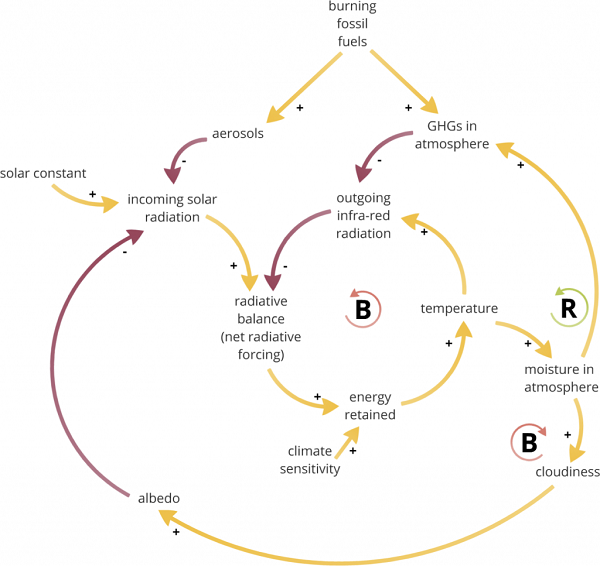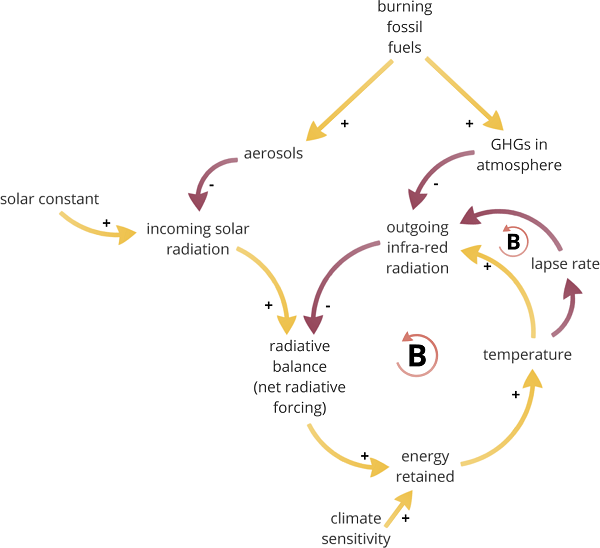
|
Mother Pelican
A Journal of Solidarity and Sustainability
Vol. 10, No. 6, June 2014
Luis T. Gutiérrez, Editor
|
|
|
|

|
|
|
The Climate as a System
Part 5: Cloud Feedbacks
Steve Easterbrook
Originally published in Serendipity, 3 September 2013
REPRINTED WITH PERMISSION
This is Part 5 of a series of articles
exploring the complex feedback dynamics of
GLOBAL CLIMATE CHANGE
For an analysis of the recently released IPCC report, click HERE
For a syllabus on systems thinking for global issues, click HERE
|
|
Yesterday I talked about three re-inforcing feedback loops in the earth system, each of which has the potential to accelerate a warming trend once it has started. I also suggested there are other similar feedback loops, some of which are known, and others perhaps yet to be discovered. For example, a paper published last month suggested a new feedback loop, to do with ocean acidification. In a nutshell, as the ocean absorbs more CO2, it becomes more acidic, which inhibits the growth of phytoplankton. These plankton are a major source of sulphur compounds that end up as aerosols in the atmosphere, which seeds the formation of clouds. Less clouds mean lower albedo, which means more warming. Whether this feedback loop is important remains to be seen, but we do know that clouds have an important role to play in climate change.
I didn’t include clouds on my diagrams yet, because clouds deserve a special treatment, in part because they are involved in two major feedback loops that have opposite effects:

Two opposing cloud feedback loops. An increase in temperature leads to an increase in moisture in the atmosphere. This leads to two new loops…
|
As the earth warms, we get more moisture in the atmosphere (simply because there is more evaporation from the surface, and warmer air can hold more moisture). Water vapour is a powerful greenhouse gas, so the more there is in the atmosphere, the more warming we get (greenhouse gases reduce the outgoing radiation). So this sets up a reinforcing feedback loop: more moisture causes more warming causes more moisture.
However, if there is more moisture in the atmosphere, there’s also likely to be more cloud formation. Clouds raise the albedo of the planet and reflect sunlight back into space before it can reach the surface. Hence, there is also a balancing loop: by blocking more sunlight, extra clouds will help to put the brakes on any warming. Note that I phrased this carefully: this balancing loop can slow a warming trend, but it does not create a cooling trend. Balancing loops tend to stop a change from occurring, but they do not create a change in the opposite direction. For example, if enough clouds form to completely counteract the warming, they also remove the mechanism (i.e. warming!) that causes growth in cloud cover in the first place. If we did end up with so many extra clouds that it cooled the planet, the cooling would then remove the extra clouds, so we’d be back where we started. In fact, this loop is nowhere near that strong anyway. [Note that under some circumstances, balancing loops can lead to oscillations, rather than gently converging on an equilibrium point, and the first wave of a very slow oscillation might be mistaken for a cooling trend. We have to be careful with our assumptions and timescales here!].
So now we have two new loops that set up opposite effects – one tends to accelerate warming, and the other tends to decelerate it. You can experience both these effects directly: cloudy days tend to be cooler than sunny days, because the clouds reflect away some of the sunlight. But cloudy nights tend to be warmer than clear nights because the water vapour traps more of the escaping heat from the surface. In the daytime, both effects are operating, and the cooling effect tends to dominate. During the night, there is no sunlight to block, so only the warming effect works.
If we average out the effects of these loops over many days, months, or years, which of the effects dominate? (i.e. which loop is stronger?) Does the extra moisture mean more warming or less warming? This is clearly an area where building a computer model and experimenting with it might help, as we need to quantify the effects to understand them better. We can build good computer models of how clouds form at the small scale, by simulating the interaction of dust and water vapour. But running such a model for the whole planet is not feasible with today’s computers.
To make things a little more complicated, these two feedback loops interact with other things. For example, another likely feedback loop comes from a change in the vertical temperature profile of the atmosphere. Current models indicate that, at least in the tropics, the upper atmosphere will warm faster than the surface (in technical terms, it will reduce the lapse rate – the rate at which temperature drops as you climb higher). This then increases the outgoing radiation, because it’s from the upper atmosphere that the earth loses its heat to space. This creates another (small) balancing feedback:

The lapse rate feedback – if the upper troposphere warms faster than the surface (i.e. a lower lapse rate), this increases outgoing radiation from the planet.
|
Note that this lapse rate feedback operates in the same way as the main energy balance loop – the two ‘-’ links have the same effect as the existing ‘+’ link from temperature to outgoing infra-red radiation. In other words this new loop just strengthens the effect of the existing loop – for convenience we could just fold both paths into the one link.
However, water vapour feedback can interact with this new feedback loop, because the warmer upper atmosphere will hold more water vapour in exactly the place where it’s most effective as a greenhouse gas. Not only that, but clouds themselves can change the vertical temperature profile, depending on their height. I said it was complicated!
The difficulty of simulating all these different interactions of clouds accurately leads to one of the biggest uncertainties in climate science. In 1979, the Charney report calculated that all these cloud and water vapour feedback loops roughly cancel out, but pointed out that there was a large uncertainty bound on this estimate. More than thirty years later, we understand much more about the how cloud formation and distribution are altered in a warming world, but our margins of error for calculating cloud effects have barely reduced, because of the difficulty of simulating them on a global scale. Our best guess is now that the (reinforcing) water vapour feedback loop is slightly stronger than than the (balancing) cloud albedo and lapse rate loops. So the net effect of these three loops is an amplifying effect on the warming.
ABOUT THE AUTHOR
Steve M. Easterbrook is a professor of Computer Science at the University of Toronto. Professor Easterbrook's research is focused on software engineering for climate system modeling, and the following is a list of recent publications:
- Engineering the Software for Understanding Climate Change, Steve M. Easterbrook and Timothy C. Johns, IEEE Computing in Science and Engineering, November 2009.
- Initial Value vs. Boundary Value Problems, Steve Easterbrook, Serendipity, 16 January 2010.
- Climate Change: A Software Grand Challenge, Steve M. Easterbrook, Serendipity, 24 August 2010.
- Guest Editors’ Introduction: Climate Change - Science and Software, S. M. Easterbrook, P. N. Edwards,V. Balaji, R. Budich, IEEE Software, 2011
- Why Systems Thinking?, Steve M. Easterbrook, Serendipity, 20 August 2013.
- The Climate as a System, Part 1: The Central Equilibrium Loop, Steve M. Easterbrook, Serendipity, 22 August 2013.
- The Climate as a System, Part 2: Energy Consumption, Steve M. Easterbrook, Serendipity, 26 August 2013.
- The Climate as a System, Part 3: Greenhouse Gases, Steve M. Easterbrook, Serendipity, 27 August 2013.
- The Climate as a System, Part 4: Earth System Feedbacks, Steve M. Easterbrook, Serendipity, 2 September 2013.
- The Climate as a System, Part 5: Clouds, Steve M. Easterbrook, Serendipity, 3 September 2013.
-
What Does the New IPCC Report Say About Climate Change?, Steve M. Easterbrook, Serendipity, 8 October 2013.
- Systems Thinking for Global Problems, Steve M. Easterbrook, Graduate Course Outline, University of Toronto, 2 December 2013.
- Climate Model vs. Satellite Data, Steve Easterbrook, Serendipity, 14 February 2014.
- Weather Balloons vs. Climate Balloons, Steve Easterbrook, Serendipity, 21 February 2014.
- TEDx Talk: Should We Trust Climate Models?, Steve Easterbrook, Serendipity, 23 May 2014.
For more information about this author, see his UT Webpage and his Serendipity Blog.
|
|Back to Title|
Page 1
Page 2
Page 3
Page 4
Page 5
Page 6
Page 7
Page 8
Page 9
Supplement 1
Supplement 2
Supplement 3
Supplement 4
Supplement 5
Supplement 6
PelicanWeb Home Page
|
|
|
|
"The world is charged with the grandeur of God!"
— Gerard Manley Hopkins (1844-1889)
|
|
Page 8
|
|
FREE SUBSCRIPTION
|
![[groups_small]](groups_small.gif)
|
Subscribe to the
Mother Pelican Journal
via the Solidarity-Sustainability Group
Enter your email address:
|
|
|
|